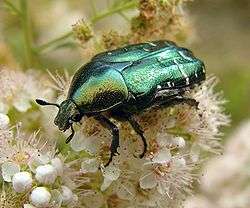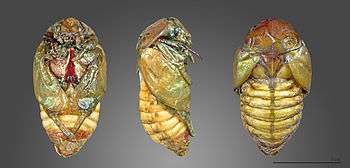Cetonia aurata
| Cetonia aurata | |
|---|---|
 | |
| Scientific classification | |
| Kingdom: | Animalia |
| Phylum: | Arthropoda |
| Class: | Insecta |
| Order: | Coleoptera |
| Family: | Scarabaeidae |
| Subfamily: | Cetoniinae |
| Genus: | Cetonia |
| Species: | C. aurata |
| Binomial name | |
| Cetonia aurata (Linnaeus, 1758) | |
| Subspecies | |
| |
Cetonia aurata, called the rose chafer or the green rose chafer, is a beetle, 20 mm (¾ in) long, that has a metallic structurally coloured green and a distinct V-shaped scutellum. The scutellum is the small V-shaped area between the wing cases; it may show several small, irregular, white lines and marks. The underside of the beetle has a coppery colour, and its upper side is sometimes bronze, copper, violet, blue/black, or grey.
Cetonia aurata should not be confused with the North American rose chafer, Macrodactylus subspinosus, or with the rarely seen noble chafer, Gnorimus nobilis, which is very similar to the rose chafer. One way to identify Cetonia aurata is to look at its scutellum; on the noble chafer the scutellum is an equilateral triangle, but on the rose chafer it is an isosceles triangle.
Overview
Rose chafers are capable of fast flight; they fly with their wing cases down. They feed on pollen, nectar, and flowers, especially roses. They can be found among roses on warm sunny days from May until June or July, and occasionally as late as September. Rose chafers are found in southern and central Europe and in the southern part of the United Kingdom, where they sometimes seem to be very localized. They are a beneficial saprophagous species (detritivores).
Life cycle
The larvae are C–shaped and have a firm, wrinkled, hairy body, a small head, and tiny legs. The larvae overwinter wherever they have been feeding, which may be in compost, manure, leaf mould, or rotting wood. They grow very quickly and will have moulted twice before the end of autumn. They have a two-year life cycle. They pupate in June or July. Some adult beetles may emerge in autumn, but the main emergence is in spring, when the beetles mate. After mating, the female beetles lay their eggs in decaying organic matter and then die.
Coloration
The metallic green coloration of the beetle is created structurally,[1] caused by the reflection of mostly circularly polarised light; like other scarabs this is left circularly polarised.[1] When viewed through a right circular polariser, the beetle appears to be colorless.[2]
Gallery
-

Larva
-

Pupa
-
.jpg)
Adult
-

With outspread wings; note the closed elytra
-

Flight pattern
-

Cetonia aurata
-

Color variations
See also
References
- 1 2 A. A. Michelson (1911). "On metallic colourings in birds and insects". Philosophical Magazine. 21: 554–567. doi:10.1080/14786440408637061.
- ↑ Hegedüsa, Ramón; Győző Szélb; Gábor Horváth (September 2006). "Imaging polarimetry of the circularly polarizing cuticle of scarab beetles (Coleoptera: Rutelidae, Cetoniidae)". Vision Research. 46 (17): 2786–2797. doi:10.1016/j.visres.2006.02.007. PMID 16564066. Retrieved 2009-05-26.
External links
| Wikispecies has information related to: Rose chafer |
| Wikimedia Commons has media related to Cetonia aurata. |
- La Cétoine Dorée (Cetonia aurata) (Coléoptère Cetoniidae)
- Photos of Cetonia aurata
- Photos of Rose chafer - Cetonia aurata and other flower beetles.
- Rose chafer Cetonia aurata, some life cycle photos.
- Color of Cetonia aurata through 3D movie glasses, a 23 second YouTube video demonstrating the handedness of the shiny color of the beetle.